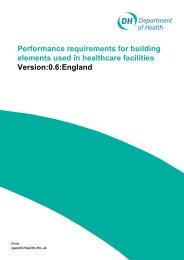Early Life Nutrition and Lifelong Health - Derbyshire Local Medical ...
Early Life Nutrition and Lifelong Health - Derbyshire Local Medical ...
Early Life Nutrition and Lifelong Health - Derbyshire Local Medical ...
Create successful ePaper yourself
Turn your PDF publications into a flip-book with our unique Google optimized e-Paper software.
BMA Board of Sciencediseases including cardiovascular <strong>and</strong> metabolic disease, ‘precocious’ puberty, osteoporosis<strong>and</strong> some forms of cancer. Underst<strong>and</strong>ing the epigenetic processes thus holds the key tounderst<strong>and</strong>ing the underlying pathophysiology <strong>and</strong> to developing approaches to early diagnosis,prevention <strong>and</strong> treatment of these diseases (see Appendix 1).Maternal undernutrition <strong>and</strong> long-term outcomes in the offspringNewborn size is related to maternal energy balance, increasing with the mother’s BMI <strong>and</strong>adiposity. Her height, <strong>and</strong> independently leg length, head circumference <strong>and</strong> birth weight, predictthe baby’s size, suggesting that her own early nutritional biology influences how she nourishes thefetus. 86, 87 The ‘fetal origins hypothesis’ proposed that maternal ill health, poverty <strong>and</strong> undernutritionimpair fetal <strong>and</strong> infant growth <strong>and</strong> were root causes of adult chronic disease. 88 If this is so, indicesof poor maternal nutrition would be associated with cardiovascular disease or its risk factors in theoffspring. So far, unfortunately, there are only crude data available to test this.There is very little evidence concerning the effects of maternal undernutrition <strong>and</strong> nutrition in thedeveloping world on the longer term health of the offspring. Studies in developing or historicallypoor countries have shown that low maternal weight, BMI or skinfold thickness in pregnancy areassociated with higher offspring blood pressure, 89, 90 insulin resistance 91, 92 <strong>and</strong> risk of CHD. 93 Followupof people exposed to the 1944-45 Dutch Hunger Winter showed that exposure of the motherto acute famine was associated with increased cardiovascular risk in the adult offspring. Outcomesvaried according to the timing of famine exposure; 94 late gestation exposure was associated withgreater risk of glucose intolerance <strong>and</strong> early gestation exposure with obesity, atherogenic lipidprofiles <strong>and</strong> CHD. Famine effects were independent of birth weight, suggesting that maternalundernutrition may impair adult health without reducing size at birth.The Institute of <strong>Nutrition</strong> of Central America <strong>and</strong> Panama (INCAP) trial in Guatemala (1969-77) isthe only r<strong>and</strong>omised trial of a nutritional intervention in which cardiovascular risk factors have beenmeasured in the adult offspring. 95 In the original trial, pregnant women <strong>and</strong> children received one oftwo supplements: a high-protein, high-energy drink or a lower nutrient drink. There was nodifference in birth weight between these two groups but the children of mothers who received ahigh-protein, high-energy drink had lower blood triglyceride <strong>and</strong> higher high-density lipid (HDL)cholesterol concentrations in adult life (profiles usually associated with better cardiovascular health).The Pune Maternal <strong>Nutrition</strong> Study was set up specifically to investigate the relationship ofmaternal nutrition to the children’s future risk of diabetes <strong>and</strong> heart disease. It collectedprospective information on diet, workload <strong>and</strong> micronutrient status in pregnant women in ruralIndian villages. At six years of age the children were thin by international st<strong>and</strong>ards but had ahigher percentage body fat than European children. Maternal folate concentrations predictedhigher insulin resistance in the child, <strong>and</strong> children born to mothers with the lowest vitamin B12concentrations <strong>and</strong> highest folate concentrations were the most insulin resistant. 96, 97 Thus animbalance in the mother in two vitamins important in methyl group provision predicted higheradiposity <strong>and</strong> insulin resistance in the child, suggesting an important role for 1-carbon metabolismin the developmental origins of type 2 diabetes.<strong>Early</strong> life nutrition <strong>and</strong> lifelong health 21



